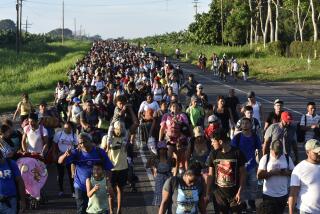Central Americans Seeking U.S. Asylum Surge
- Share via
Central Americans seeking work in the United States are increasingly taking the risky step of filing for political asylum in what U.S. authorities and immigrant advocates say is an unintended consequence of the 1986 immigration law.
In San Diego, officials of the U.S. Immigration and Naturalization Service have already received more than 350 asylum applications, mostly from Central Americans, during the current fiscal year, which has more than three months to go. Officials received 306 applications during all of fiscal 1987.
“The numbers have been up all year,” said Randell Romine, a supervisory immigration examiner with the service in San Diego.
Asylum applications from Central Americans have risen substantially this year nationwide. The surge is perhaps most dramatic in the Los Angeles area, where more than 16,000 foreigners, mostly Central Americans, filed during the first five months of 1988. Fewer than 1,000 filed during the same period in 1987, according to the U.S. Immigration and Naturalization Service.
“We’re backed up; we’ve got boxes and boxes of applications that we have to get to,” said Avelino Geaga, supervisory immigration examiner for the Los Angeles district, which covers a seven-county region that houses the largest Central American community in the United States.
Why are they filing? Faced with the prospect of unemployment, officials and others say, many undocumented Central Americans have opted to come out of the shadows and seek asylum in hopes of obtaining so-called “work authorization” cards, which allow them to work in the United States while their applications are pending.
The 1986 Immigration Reform and Control Act requires that employers ask their workers for such documentation before hiring them, and imposes civil and criminal sanctions against employers who don’t comply. Full enforcement of the sanctions began last Sept. 1, which is about when authorities began to notice the surge in applications.
“They need work authorization, and this is the quickest way to get it,” said Harold Ezell, regional commissioner for the immigration service, who condemned the practice as an “abuse”--a position challenged by immigrant advocates.
“These people are filing these applications out of absolute necessity,” said Marco Antonio Rodriguez, executive director of Centro de Asuntos Migratorios, an immigrant-assistance organization based in Chula Vista.
The applications are double-edged because less than 4% of Salvadorans and Guatemalans who apply have been granted political asylum, according to immigrant groups that monitor applications. Acceptance rates for applicants from leftist Nicaragua topped 80% last year, critics note, a disparity that they have charged illustrates the “politicization” of the asylum process.
Thus, while applicants from El Salvador and Guatemala may extend their time here for a year or more through the application process and subsequent appeals, many will likely face deportation. Unlike applicants under the recently expired amnesty program, the applications of unsuccessful asylum-seekers do not remain confidential, and are used in deportation proceedings.
“In the past,” Rodriguez said, “most people didn’t apply for asylum, because it would expedite their deportation.”
Nonetheless, Central Americans have been increasingly applying for asylum, apparently seeing few alternatives at a time when it is becoming more difficult for many to find work without some kind of documentation.
“They’re taking a very great risk,” said the Rev. John Fife, a Presbyterian minister in Tucson, Ariz., who has long been active in the asylum movement for Central Americans. “But, when faced with the possibility of their children going hungry, they’ve decided to take this risk.”
‘Well-Founded Fear’
U.S. law raises the possibility of asylum for foreigners who can prove they have a “well-founded fear” of persecution based on race, religion, political belief or membership in particular organizations. However, the program has been the focus of intense debate in the past decade as critics have charged that U.S. officials favor citizens of leftist nations.
Despite Ezell’s contention that the Central Americans are abusing the system, immigrant rights groups assert that most applicants from El Salvador and Guatemala do face potential persecution at home, but have held off from applying until now because of the low acceptance rates for their countrymen.
The recent increase in applications is most pronounced among Salvadorans and Guatemalans. An upsurge in applications among Nicaraguans that began in early 1987 is also continuing, the INS said.
Between Oct. 1 and April 30, according to the INS, almost 14,000 Salvadorans nationwide applied for asylum--contrasted with fewer than 3,000 in the entire previous fiscal year.
During the same period, almost 3,000 Guatemalans filed for asylum, more than four times as many as filed during all of fiscal 1987.
More than 10,000 Nicaraguans applied during the October-April period. About 13,400 applied during all of the previous fiscal year.
More to Read
Sign up for Essential California
The most important California stories and recommendations in your inbox every morning.
You may occasionally receive promotional content from the Los Angeles Times.










